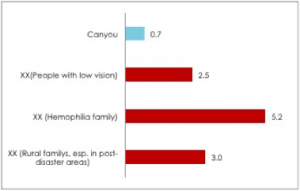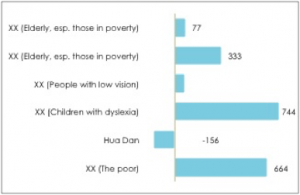Social Enterprises: Testing the Water
Social Enterprises (SEs) in China are emerging, each busy exploring their future in their own ways. We see trial and error; we see opportunities and risks. How should we objectively appraise SEs’ performance and potential? VA wants to give a few insights.
It is known that SEs typically have two advantages compared to traditional NGOs. One is their innovative approaches to particular social problems and bringing welfare to different target beneficiaries. Among the SEs we have encountered, there are basically two types: service type and employment type.
Service-type SEs are the majority, providing products and services to the bottom of pyramid group. For example, LangLang Learning Potential Development Center(乐朗乐读) aims to develop the China industry standard for treating dyslexia, as well as help children and their parents overcome the technical, social and psychological difficulties associated with the condition. Their revenue comes from tuition. Instead of directly serving beneficiaries, some service-type SEs provide intermediary services by supporting charitable organizations or projects. Buy42.com (善淘网), for instance, is an online charity shop that sells second-hand stuff to raise fund for NGOs.
Employment-type SEs help beneficiaries to generate income. A typical example is Qiang Embroidery (羌绣). It trains local Qiang ethnic women to make embroidery products and supports their livelihood by commercializing those products.
We have the confidence to conclude that Chinese SEs are quite successful in terms of innovation. How about efficiency – the other advantage of SEs – in resource utilization, business operation and sustainability? It turns out that lack of efficiency is a common problem across the SEs we have evaluated. As for employment–type SEs, we look at investment to generate every ¥1 income for each beneficiary. Among the four SEs we evaluated, only Canyou (残友) was able to generate income for employees with less unit cost (see the following Chart). The others are kept anonymous, only their respective beneficiary groups.
As for service-type SEs, we focus on their net investment to service each beneficiary (RMB). Among the six SEs we evaluated, only Hua Dan (花旦) is already making a profit (see below).
Apparently, only a few SEs are able to break even at this point. But the majority are close, with cost/income ratio in the range of 100~200%, promising to make profit within short/medium term. To increase efficiency, SEs need to increase scale or refine their target customers and pricing strategy.
The emergence of SE is by no means intended to replace traditional nonprofit. It is more of an alternative in this resource-constraint world. Although its advantages over the traditional nonprofit model are not yet prominent, especially in terms of efficiency, we have faith in its potential. Take Canyou as an example. For Canyou to reach its scale and efficiency today – employing 3760 physically disadvantaged people and costing only 0.7 RMB to help each employee earn 1 RMB of income – it takes more than ten years of development and continuous investment.
We understand the bottleneck of SEs in scaling up is its lack of business expertise, external funding and policy support. We do not want social entrepreneurs to be discouraged when their businesses are still at an early or growing stage. That is exactly why we initiated Pheonix 2016 project and Yu Fund. History enlightens us, innovation always comes with risk; but the truth shall be unfolded over time. We believe social entrepreneurship is a direction that philanthropy must go. Let’s just wait and see.


